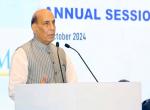India, as a nation, seems to have gained notoriety for not learning from the past mistakes. Equally glaring is India’s consistent failure to respond to the emerging situations with the speed and seriousness it deserves. And no wonder that the history keeps repeating itself with stunning regularity. Indeed, it took 26/11 for the Indian government to be jolted out of its ‘smugness and slumber’ to announce an ambitious plan to strengthen the coastal security architecture through a slew of measures. But here again the slow pace of the implementation of the projects as highlighted by the delay in the acquisition –the bane of India’s defence modernisation programme-- could once again expose the long, porous and poorly guarded sea front of the country to attacks from across the sea channels. There is no denying the fact that the terror attack on the commercial metropolis of Mumbai by Pak trained terrorists, who landed on the Indian mainland through the Arabian Sea channel by means of a hijacked fishing vessel, did expose the soft under belly of India’s coastal security architecture. Says New Delhi based security expert and Director of the National Maritime Foundation Uday Bhaskar, “Our country is sea blind. Just securing the borders on the land is not enough”. In the similar vein, India’s audit watch dog CAG(Comptroller and Auditor General)coming down heavily on the Indian coastal security mechanism observed, “In an era of heightened coastal security concerns, Indian Coast Guard remains ill equipped to discharge its enhanced role and meet the challenges of today.”
In fact, a widely reported incident post 26/11 did once again illustrate the typical mind set of “bolting the stables after the horses have left.” The glaring failure of the Indian coastal security agencies to monitor the movement of the Panamian merchant ship MT Pavit, which mysteriously grounded at Mumbai’s Varsova beach in August this year, has proved to be a huge jigsaw puzzle. That the abandoned MT Pavit could break the multi layered coastal security mechanism to land up at Mumbai’s beach front stands out as a sad commentary on the poor maritime security apparatus that India has put in place. Meanwhile, there is a speculation that the Pakistani-Iranian crew of an Iranian dhow captured by Indian Naval vessel INS Rajput, 180 nautical miles from Bitra Island in Lakshadweep group in Dec.2010, had planned a Mumbai type terror attack on a spot in Kerala. The crew of the dhow Al Javaidi consisting of 17 Pakistanis and Iranians told the Indian Navy personnel that they were engaged in fishing and had deviated to the oceanic region near Lakshadweep fearing pirates. Though the crew claimed not to have docked at any port since its departure from Jabra in Iran, much of the ration found on board the ship was found to be of Pakistani origin including a match box made in Mirpur in Pak occupied Kashmir. And this has raised the possibility of the dhow having docked at one of the Pakistani ports. Suspicion of the Indian security agencies only increased after a crew, claiming to be a citizen of Iran, spoke fluent Hindi with an accent unique to the Kashmir valley.
“In view of the vulnerability of Indian island groups of Lakshadweep and Andaman and Nicobar islands, efforts are being made to strengthen their security. The Government is aware of the strategic importance of Andaman and Nicobar and Lakshadweep and has been taking steps to enhance their security,” said P. Chidambaram, Indian Home Minister. Proximity of Lakshadweep to Maldives, some of whose nationals are known to have been trained by Pakistani terrorist groups, is a matter of concern for the Indian coastal security agencies. Added to that, in recent months, Somalian origin sea brigands have spread their influence to the Arabian Sea region. Indeed the possibility of the islands of Seychelles, Mauritius and Maldives becoming a stage post for sea piracy and the promotion of maritime terrorism is not ruled out. Incidentally, “Operation Island Watch” launched by the Indian Navy and Coast Guard in March 2011 resulted in the capture of Somalian pirates operating west of Lakshadweep islands after a fierce gun battle.
Similarly the need to strengthen security mechanism in Andaman and Nicobar island groups has assumed added significance in view of the growing Chinese maritime footprints over Myanmar and Bangladesh. China, which has already built a string of ports in Myanmar, will also be building an all weather deep water sea port at Sonadia near Chittagong in Bangladesh. Moreover, Bay of Bengal is vital to India’s energy security since it has huge reserves of oil and gas. Further the possibility of pirates off the coast of Bangladesh targeting ships in the Bay of Bengal cannot be ruled out. Not long back, pirate fishing vessels from Taiwan and Thailand operating in the Bay of Bengal were a common sight.
Meanwhile, there are reports of the Chinese fishing vessels moving actively in India’s eastern coast close to Wheeler Island from where Indian missiles are regularly flight tested. There is a speculation that these fishing vessels could just be a cover to collect vital data on the Indian missile launches. Indeed, a few days before the Pak sponsored terror struck Mumbai, Antony had stressed on the need to protect India’s 7516,-km long coastal stretch much the same way as the land borders.
Interestingly, the former Indian naval chief Suresh Mehta in the aftermath of the Mumbai terrorist attack had cited operational problems involved in checking each of the 150,000 fishing boats plying around the oceanic waters around India. Against this backdrop, the Government of India has made it mandatory for the registration of all the fishing vessels in the country. As it is a majority of fishing boats now plying in the oceanic waters around India remain un-registered. In addition there is also a plan to involve fishermen in the coastal security plan. There is no denying the fact that the fishermen can serve as the first line of defence in so far as the coastal security is concerned. In fact, prior to26/11 episode, fishermen had noticed a group of strangers landing in the shallow waters of the Arabian Sea on the outskirts of Mumbai. In this context the coast guard is holding regular community interaction meetings with the fishermen in the coastal belt to create awareness about maritime security. However, the plan to set up coastal police stations is proceeding at a snail’s pace. Similarly, the plan to boost the operational edge of the existing coastal e police stations through the state of art communications equipment and high speed boats is also lagging behind.
Indeed as stated by Antony, “The protection of our EEZ (Exclusive Economic Zone) is vital to the rapid economic growth of the country. For, we are living in a world of uncertainty with threats from maritime terrorism, piracy, narcotics smuggling and low intensity conflicts. The security of our sea lanes, communications lines and offshore infrastructure will have to be ensured for the sustainable development”.
The state of Gujarat which boasts of a number of ports, oil refineries and industrial units along its coasts need to be extra vigilant because it shares borders with Pakistan. For long, the porous coast of Kutch had remained the stage post of arms and ammunition running by groups inimical to India. This is not to suggest that the coastal stretch in the rest of the country is safe and secure; far from it. For instance, the Arabian sea coast along Kerala had widely been used by LTTE (Liberation Tiger of Tamil Eelam), an assortment of jihadi groups, smugglers and drug runners. In the backdrop of the reports of LTTE trying to regroup, there is a need to mount vigilance along the Tamilnadu sea coast. Indeed, only an eternal and effective security along both the eastern and western coastline can ensure the safety of mainland India. It took 26/11 incident for the Government of India to designate the navy as the nodal authority charged with the task of ensuring the coastal security in all its manifestations. This implies that the navy will be required to coordinate with 27 different state and central agencies to monitor the Indian coastal stretch and ensure maritime security. Lack of coordination among the multitudes of agencies involved in ensuring India’s maritime security was a major causative factor for the mainland India being exposed to terror threat from across the high seas.
The elite, 1000 strong Sagar Prahari Bal (SPB) set up by Indian Navy in the aftermath of 26/11 will take care of defence equipment in the shallow waters around India. While this force currently uses hired boats for patrolling, the Indian Navy is in the process of acquiring 80 fast interceptor craft for SPB. On another front, the plan to set up 45 static radars along the coastal stretch of the country along the mainland and Lakshadweep and Andaman and Nicobar group of islands is picking up. These highly sensitive radars in addition to detecting low flying objects can also identify boats and vessels sailing in the ocean waters from a distance of 15-20 nautical miles.
Not long back, Suresh Mehta had hinted at the possibility of cargo containers being employed to transport nuclear devices to pre determined targets by the terrorist groups. In particular the observation of Suresh Mehta applies to the hard core fundamentalist Islamic groups-- active in the poorly governed and failed state of Pakistan--which in league with a section of Pakistan’s defence set, could lay its hands on the nuclear weapons. Toady 70-75% of the global sea going cargo is containerized. Naturally, there is a growing concern about the safety of container transportation.
The need to strengthen security in and around the Indian ports, which play a major role in country’s export-import business, has nudged the Indian Shipping Ministry to create an elite commando force equipped to take care of the security of the ports and harbours in the country. As envisaged now, each of the major Indian ports considered to be vulnerable to terrorist threat would be guarded by a group of 60 commandos equipped with the latest genre of weapons and communications devices. India has 12 major ports and 200 minor ports which account for 90% by volume and 79% by value of country’s total foreign trade. This initiative assumes significance in the context of the observation by Suresh Mehta.
Looking beyond the threat from terrorists, pirates and arms traffickers, the Indian maritime security architecture should aim at securing Indian interests in oceanic waters beyond India’s immediate neighbourhood. Indeed, in the context of Chinese muscle flexing in the Indian Ocean, the Indian Navy should upgrade its capability in terms of technology, equipment and human resources to expand its footprint in this strategically located, commercially significant water body. Chinese naval presence in the Indian Ocean for anti piracy operations would receive a further boost by the permission granted to China to go in for deep sea mining in the Indian Ocean region.
It is in the fitness of things that India should join hands with Vietnam to thwart the Chinese hegemonistic ambitions in the disputed South China Sea region. Indian Prime Minister Manmohan Singh was right in his observation made during Vietnamese President Truong Tan Sang’s India visit in October, “India and Vietnam are maritime neighbours. We face common security challenges from terrorism, piracy and natural disasters. We believe that it is important to ensure the safety and security of the vital sea lanes of communications. We have agreed to continue and strengthen our exchanges in these fields.”
As it is, the agreement between India and Vietnam’s state owned oil companies includes new investment and the exploration and supply of oil and gas to the two countries. Irked by the Indian exploration projects on Vietnamese blocks in South China Sea, Chinese authorities raised objections claiming that it transgressed their area of control. The Chinese claim on the South China Sea was rejected by both India and Vietnam. India has also made it clear that Oil and Natural Gas Corporation Videsh (ONGCV), India’s state owned venture, would continue to explore the resources rich South China Sea. For India’s stand is that any country has the right of passage over this international maritime area according to UN Convention on the Law of Sea (UNCLOS). China has claimed that South China Sea and all the islands including Spartly and Parcel belong to it. “China enjoys indisputable sovereignty over the South China Sea. China’s stand is based on historical facts and international,” said a spokesman of Chinese external affairs ministry. As strategic analysts point out, the expansionist claims of this Asian communist giant has spurred a veritable arms build up in the region—from South Korea to Malaysia and Vietnam. Not surprisingly then countries which are embroiled in dispute over South China Sea with China are responding to the Chinese sabre rattling much the same way as a India is responding to the perception of heightened threat from China on land and sea.
Observers say that India should do utmost for Vietnam in the defence sector much the same way as China has done to Pakistan by bolstering its defence preparedness. In South China Sea, Vietnam is the only credible power that can withstand the onslaughts of China. And India should without hesitation accede to the request of Vietnam for military assistance in the areas of maritime security and naval weapons. The four areas in which Vietnam has sought Indian support are: submarine training, conversion training for its combat pilots to operate Su-30 fighters, augmentation of its strategically situated Nha Tran port and transfer of a medium sized warship. On another front, Vietnam has evinced interest in buying the Indo-Russian supersonic cruise missile BrahMos. An India-Vietnam alliance would be a win-win combine to thwart Chinese expansionist ambitions in the vital South China Sea region.
Meanwhile, China says that it has started the sea trials of what it claims to be its first aircraft carrier built around the Ukranian warship it bought as a scrap. An operational aircraft carrier would strengthen Chinese power projection capabilities in the oceanic waters especially in the disputed stretches. A group of aircraft carriers could embolden China towards reinforcing its maritime claims for the shoals, islands and islets in the South China Sea. As things stand now, China expects to have at least three aircraft carriers in service in the foreseeable future. India too hopes to have three aircraft carriers in service before the end of this decade.
Against such a scenario, Indian Navy should strive to transform itself into a three dimensional, network centric enabled and satellite augmented blue water force to project the Indian power across the global oceanic stretch with a greater degree of credence. To boost its strike capability, Indian Navy should link up its long range missiles, radars and air defence systems on its sea based platforms to a central location through a highly dedicated satellite link. Of course, the deadly BrahMos would be a major trump-card of the Indian Navy in its quest to stay ahead of the enemies.
As it is, the US Navy has been in a position to dominate the large part of the oceanic waters through its “sustained and creative” reliance on a variety of space platforms including satellites designed for communications, navigation as well as reconnaissance and surveillance. As a forward looking maritime force on the threshold of a major transformation, Indian Navy is fully well aware that ocean watch satellites snooping on the naval movements, electronic ferret satellites gathering data on radio frequencies, meteorological satellites predicting weather to facilitate an effective use of weapons, navigation satellites precisely guiding lethal weapons to designated locations with unfailing accuracy, reconnaissance satellites providing vital data on the strength of potential adversaries and communications satellites ensuring a real time link up for the effective use of resources are all puppets in the chain of the modern day warfare.
However, the biggest challenge before the Indian Navy is to stay ahead in the race to acquire the best of the technologies and dominate the oceanic waters to secure Indian interests without let or hindrance. As stated by Parag Khanna, a US based geo strategist who is also the founding director of the Global Governance at the New American Foundation “Now India is being seen as much more of a naval power—overseeing and having a strategic role with respect to the Indian Ocean and the trade routes there. That actually is the geopolitical future of India. It is a very strong future”.
-----------------------------------------------
Published Date : 12th December 2011








Post new comment